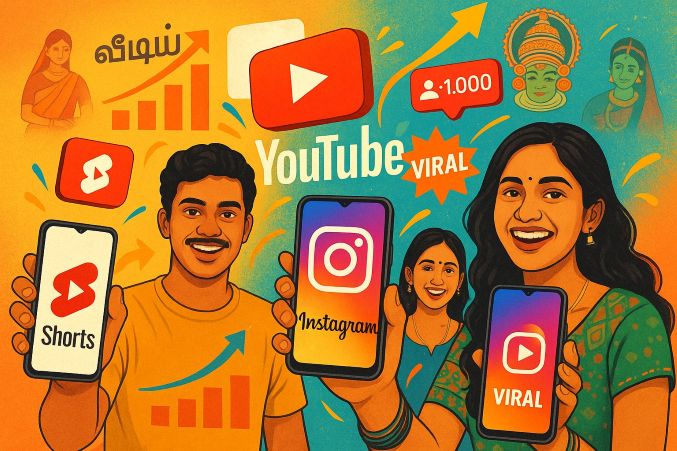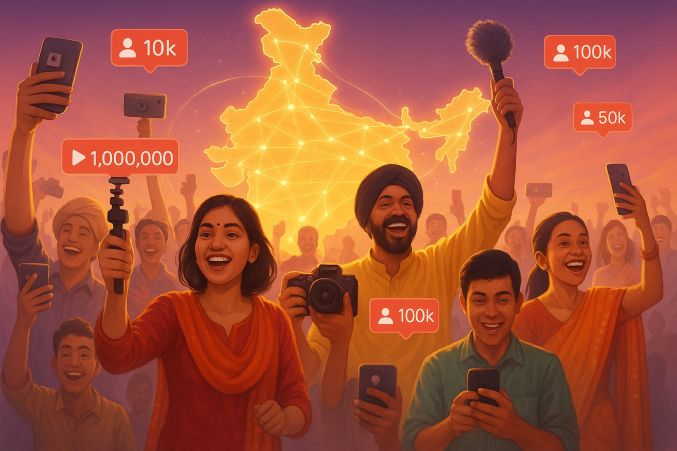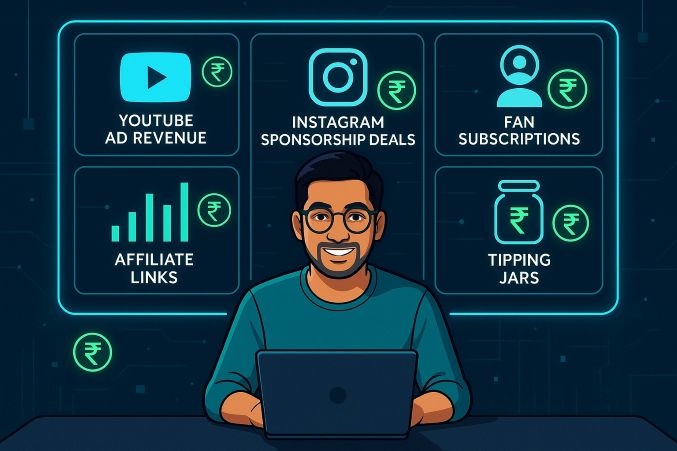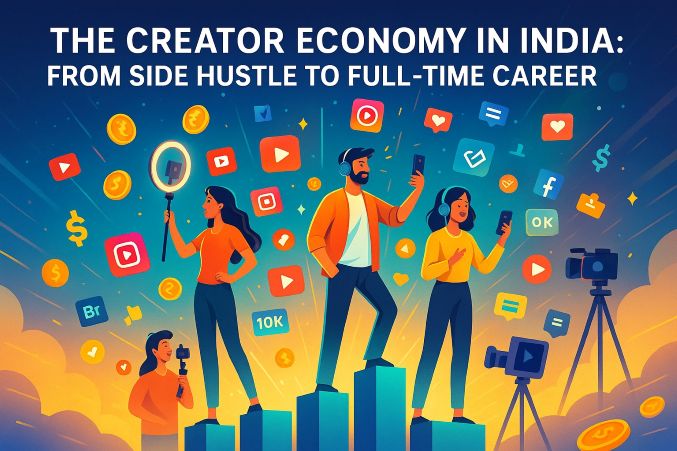The Creator Economy in India: Side Hustle to Full-Time Job
India's digital revolution has led to a thriving creator economy, turning content creation into a sustainable full-time career with huge financial and creative potential. With growth rate projections hitting warp speed, varying models of monetization, and growing backing from international platforms, brands, and even the Indian government, the creator economy is revolutionizing entertainment, marketing, and entrepreneurship in unprecedented ways.

1. The Creator Revolution in India – A Billion-Dollar Boom
India's creator economy is growing at an explosive rate, from a niche activity to a multi-billion-dollar space competing with traditional media verticals.
Market Growth: The industry was at ₹19 billion in 2023 and is expected to touch ₹34 billion by 2026, growing at 18% CAGR—higher than most traditional industries.
Driver Forces of the Boom:
- Affordable Internet & Smartphones: Jio's disruption connected 600M+ Indians to the internet, whereas affordable smartphones powered mass consumption of content.
- Short-Form Video Explosion: TikTok's ban opened up opportunities for indigenous apps such as Moj, Josh, and MX TakaTak, whereas Instagram Reels and YouTube Shorts hold sway.
- Brands Reallocating Budgets: Businesses now invest 15-30% of marketing budgets in influencer partnerships versus traditional advertising.
- Regional Content Surge: 70% of India's internet users prefer content in local languages, enabling Tier 2/3 creators.
Key Insight: India has over 80 million content creators, but only 2 million are actively monetizing—displaying massive untapped potential.

2. From Side Hustle to Main Hustle – How Much Do Creators Really Earn?
What began as a side hustle for many has now become a profitable profession, with revenues comparable to corporate packages.
Earnings Spectrum Across Tiers
|
Creator Tier |
Followers |
Monthly Earnings |
Primary Income Sources |
|
Nano |
1K–10K |
₹5K–₹20K |
Small brand deals, affiliate links |
|
Micro |
10K–100K |
₹20K–₹50K |
Local sponsorships, UGC, platform bonuses |
|
Mid-Tier |
100K–1M |
₹50K–₹2L |
Brand campaigns, YouTube ads, live gifting |
|
Macro |
1M–5M |
₹2L–₹10L |
Exclusive brand contracts, endorsements |
|
Mega |
5M+ |
₹10L+ |
TV ads, movie roles, startup investments |
Key Income Sources Breakdown:
- Brand Deals (40-60% of earnings): ₹10K–₹50K per post for micro-influencers; ₹5L+ for celebs.
- YouTube Ad Revenue: ₹50–₹500 per 1,000 views (higher for finance/tech niches).
- Affiliate Marketing: 5-20% commission on sales via Amazon, Flipkart links.
- Exclusive Platform Payouts: YouTube Shorts Fund rewarded ₹5-25L to leading creators in 2023.
Reality Check: Just 8-10% of creators are able to earn sustainably, with 90% facing inconsistent earnings—referring to the requirement for improved monetization tools.

3. Platform Powerhouses – How YouTube, Instagram & Shorts Drive the Economy
India's creator economy flourishes on social media and short-video platforms, each having different monetization tools and audience reach.
YouTube: The OG Monetization Giant
- ₹21,000 crore spent on Indian creators since 2020 through ads, grants, and equipment sponsorships.
- 75% of leading creators are from Tier 2/3 cities—regional content (Tamil, Bhojpuri, Punjabi) contributes to 60% of watch time.
Monetization Options:
- Ad Revenue (₹50–₹500 per 1K views) – Tech/finance creators make 3X more than vloggers.
- Super Chats & Memberships – Live streamers make ₹50K–₹5L/month from fan gifts.
- Shorts Fund – Leading creators received ₹5-25L/year for viral pieces.
Instagram: The Brand Collaboration Hub
- 80% of influencer partnerships occur here because of better engagement rates.
- Reels Bonuses – Meta rewarded ₹1-5L/month to chosen creators in 2023.
- Shopping & Affiliates – Beauty creators earn 20-30% commission on Nykaa products sales.
Short-Form Video Apps (Moj, Josh, Roposo)
- Virtual Gifting – Best live streamers earn ₹1-5L/month on fan gifts.
- Hyper-Local Content – 60% users belong to small towns; comedy and farming content goes viral.
Platform Wars: YouTube dominates in revenue, Instagram for brand collaborations, and Moj/Josh for Bharat's mass creators.

4. Monetization Models – Beyond Brand Deals: 6 Ways Creators Make Money
Those days of creators getting by on sponsorships are a thing of the past. Now, several money streams generate financial security:
- Brand Deals & Sponsorships (40-60% of income)
- Rates: ₹10K–₹50K per post (micro), ₹5L+ (macro).
- Trend: Performance-based deals (pay-per-sale) instead of fixed fees.
- Platform Payouts (20-30%)
- YouTube AdSense (₹50–₹500 per 1K views).
- Instagram Reels Bonuses (₹1-5L/month for leading creators).
- Affiliate Marketing (10-20%)
- Amazon affiliates offer 1-10% commissions; tech creators make ₹50K+/month.
- Fan Funding (5-15%)
- YouTube Memberships (₹500–₹5,000 per fan/year).
- Live Gifting (Moj/Josh stars make ₹1L+/month).
- Digital Products (5-10%)
- Online courses (₹5K–₹50K per sale), eBooks, presets.
- Web3 & NFTs (Emerging)
- NFT art sales, tokenized fan clubs (e.g., HustleX's creator tokens).
Case Study: A travel creator with 500K followers makes:
- ₹1L/month (YouTube ads)
- ₹2L (brand deals)
- ₹50K (affiliate links)
- ₹25K (photography course sales)
= ₹3.75L/month
5. Market Size & Growth Trajectory – The Road to ₹1 Trillion
India's creator economy has only begun, and the projected numbers are staggering compared to today's figures.
Current Landscape (2024)
- 2 million+ active creators
- Influencing $350 billion in consumer spending (through recommendations)
- Tier 2/3 creators = 75% of the ecosystem
Future Projections (2030)
- $1 trillion in creator-driven spending (BCG report)
- 50 million+ creators, with AI tools facilitating nano-influencers to scale
- Hyper-local & local content ruling (Hindi, Tamil, Telugu)
- Blockchain & AI upending monetization (smart contracts for equitable pay)
Key Takeaway: Creators will become larger than traditional celebrities, owning direct fan economies and venture investments in the next decade.
6. Geographic Shift: The Rise of Tier 2 and Tier 3 City Creators
India's digital revolution has made content creation democratic on a scale never seen before, disrupting the historic metropolitan hold on media creation. What started as an urban phenomenon with Mumbai, Delhi, and Bangalore at the center has now burst out in all parts of the country, with small-town creators at the forefront.
The Small-Town Content Revolution
- 75% of India's top creators today are now from cities such as Lucknow, Indore, Patna, and Coimbatore, as per a recent report by Hoopr.ai.
- Local content drives engagement metrics: Local language content in Hindi, Tamil, Telugu, Bengali, and Bhojpuri consistently beats English content by 3-5x in watch time and engagement.
- Low entry points make it possible for mass participation: With phones costing less than ₹7,000 and mobile data rates cheaper than anywhere else in the world, content creation tools are now affordable for millions.
Small-Town Success Case Studies
- Amit Bhadana (27M YouTube followers): The Faridabad comedian established his empire through relatable Hindi comedy of middle-class life.
- Prajakta Koli (6.5M followers): She evolved from a Mumbai suburb to India's leading female creator by interweaving Hindi-English "Mumbaiya" humor with social causes.
- Technical Guruji (21M subs): The Dubai-resident but Udaipur-born technology reviewer demonstrated regional viewers are hungry for specialist content beyond amusement.
Why Platforms Are Betting Big on Bharat
- YouTube India states that 60% of the watch time is from non-metro users.
- The algorithm on Instagram now favorably pushes regional content.
- Homegrown apps Moj and Josh have developed their whole business model around Tier 2/3 creators.
Industry Insight: A Josh representative disclosed that their highest earners are now mostly from cities such as Ranchi and Guwahati, with some earning ₹5-10 lakh/month from live gifting and brand collaborations.
7. Government and Institutional Support: Infrastructure for Creators
Realizing the potential of the creator economy to create jobs and soft power, the government and private sectors are investing unprecedented sums.
Key Government Plans
- Institute of Creative Technology (Budget: ₹4,000 crore)
- Will provide certified courses in content creation, AI tools, and digital marketing.
- Digital Media Entrepreneurship Scheme
- Provides ₹5-25 lakh grants to rural creators.
- Startup India Seed Fund
- $1 billion to be used for creator-led startups.
Corporate Contribution
- Jio's Digital Udaan Program: Offers free 5G phones, cloud storage, and editing software to 10,000 top creators every year.
- Amazon's Small Business Accelerator: Enables creators to start merchandise lines without any upfront inventory costs.
- Google's YouTube Creators Grants: Allocated ₹50 crore to 2,000 new creators in 2023 alone.
Policy Impact Analysis: These efforts could legitimize the creator economy by:
- Creating standard contracts and payment terms
- Building insurance products for gig creators
- Developing credit systems using audience metrics instead of traditional collateral
8. Challenges: The Dark Side of the Creator Economy
Hiding beneath the glitz are systemic problems that pose the risk of India's creator ecosystem being unsustainable.
Monetization Inequality
- The 1% Problem: Only 0.3% of creators (some 6,000 people) earn more than ₹10 lakh a year.
- Platform Dependency Risks: 50% of the income of a channel can be lost overnight due to algorithm updates.
Operational Challenges
- Financial Management: 78% of creators don't have formal accounting systems in place.
- Mental Health Crisis: 68% experience "always-on" pressure-induced anxiety.
- Copyright Issues: 20-30% of income lost by small creators to content theft.
Solutions Emerging
- Creator Unions: New groups agitating for standardized payment terms and mental health coverage.
- Tech Solutions: AI-powered copyright monitoring and automated accounting tools.
9. AI and Web3: The Next Frontier
The 2025-2030 decade will witness technological disruption redefine content creation itself.
AI's Transformative Impact
- Content Production: ChatGPT-5 type tools can now produce full video scripts within seconds.
- Audience Growth: Predictive algorithms recommend best posting times/content types.
- New Formats: Virtual influencers such as AI Naina (2.3M followers) land brand partnerships.
Web3 Monetization Models
- NFT Memberships: Fans buy NFT "passes" for access to exclusive content.
- Creator Tokens: Audiences invest in creator development through tokenized ecosystems.
- Decentralized Platforms: Blockchain-based substitutes for YouTube guarantee 95% revenue share.
Real-World Adoption
- Posthumous NFT collection by Punjabi singer Sidhu Moosewala raised ₹18 crore.
- Tamil tech entrepreneur "Beebom" receives 15% of revenue via Web3 channels.
10. The 2030 Outlook: A ₹1 Trillion Ecosystem
BCG estimates India's creator economy will shape ₹1 trillion of consumer spending annually by 2030 through some key advancements:
Structural Changes
- From Creators to Moguls: Leading creators will become full-scale media houses.
- Hyper-Specialization: Nano-niche makers (e.g., "Only South Indian Baking") will flourish.
- Mainstream Acceptance: Creators will emerge with National Film Awards.
Economic Impact
- Employment: Will directly employ 5 million Indians.
- Ancillary Industries: Editing software, analytics platforms, and creator complexes will become significant industries.
- Global Impact: Indian creators will conquer non-English markets in Africa, Southeast Asia.
Policy Developments
- Creator Credit Scores: Banks can lend against audience metrics.
- Content FDI: Foreign investment in creator startups up to 100% can be permitted.
- Digital IP Laws: New regulations for the protection of AI-powered content.
Final Thought: The distinction between "creator" and "mainstream entrepreneur" will vanish completely. Every small enterprise will have to acquire creator competencies in order to survive, making digital content creation as essential as literacy became in the 20th century.
Conclusion: India's Digital Renaissance
As we stand at the turning point of this revolution, a few truths emerge:
- Democratization Will Intensify: The next 100 million creators will be from villages and small towns.
- Hybrid Models Will Prevail: Successful creators will converge AI efficiency with human authenticity.
- Sustainability Needs To Be Faced: The existing "churn and burn" model needs to transform into career-span pathways.
The Road Ahead:
- 2025: AI co-creators become commonplace.
- 2027: First creator IPO (a YouTuber-led company goes public).
- 2030: Creators surpass traditional media workers.
To would-be creators, the message is clear: The gold rush is indeed on, but the rules are being written right now. Will you be part of shaping them?
What's your creator economy vision for India? Let us know in the comments! ???


Comments
No Comments To Display